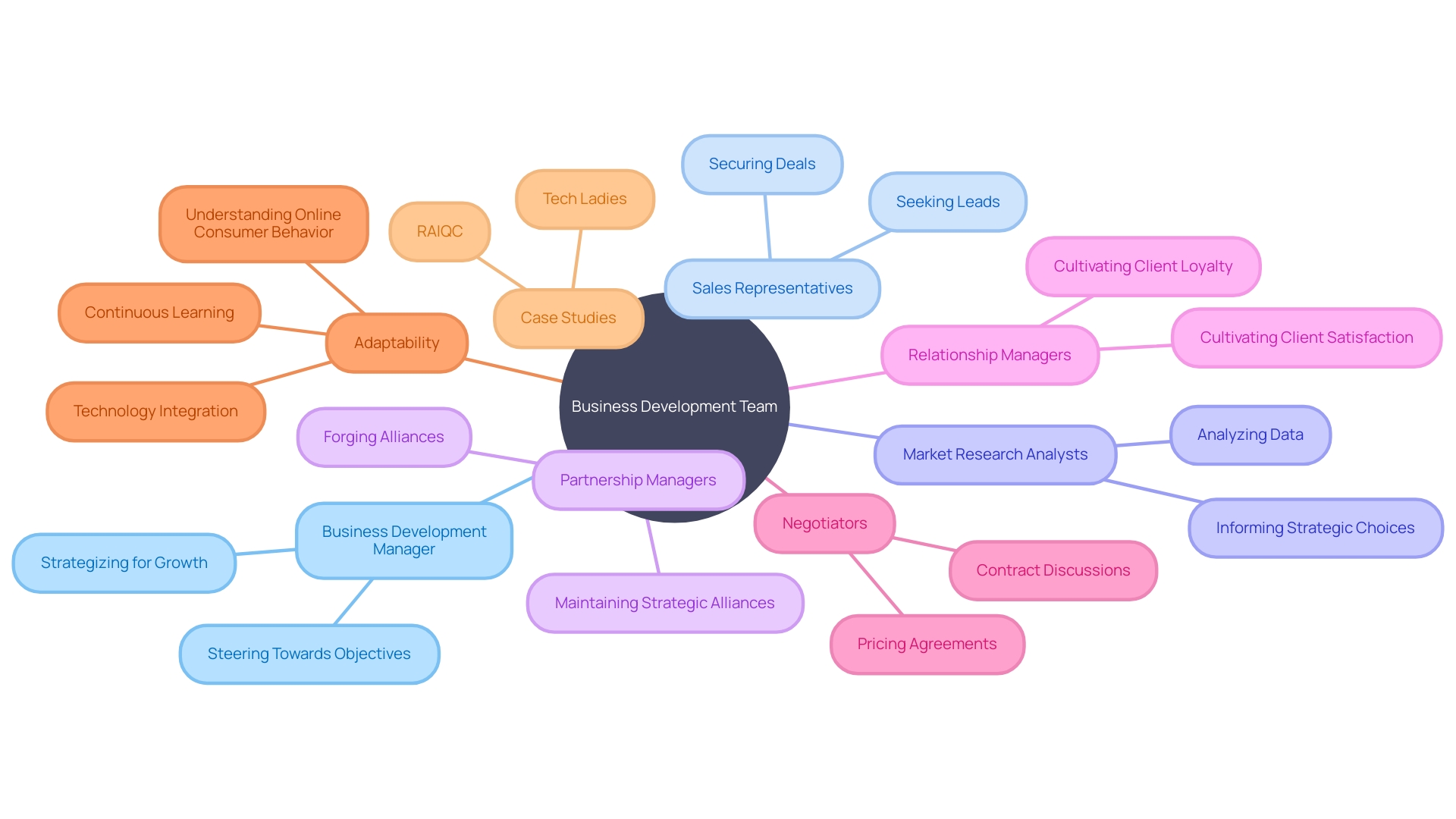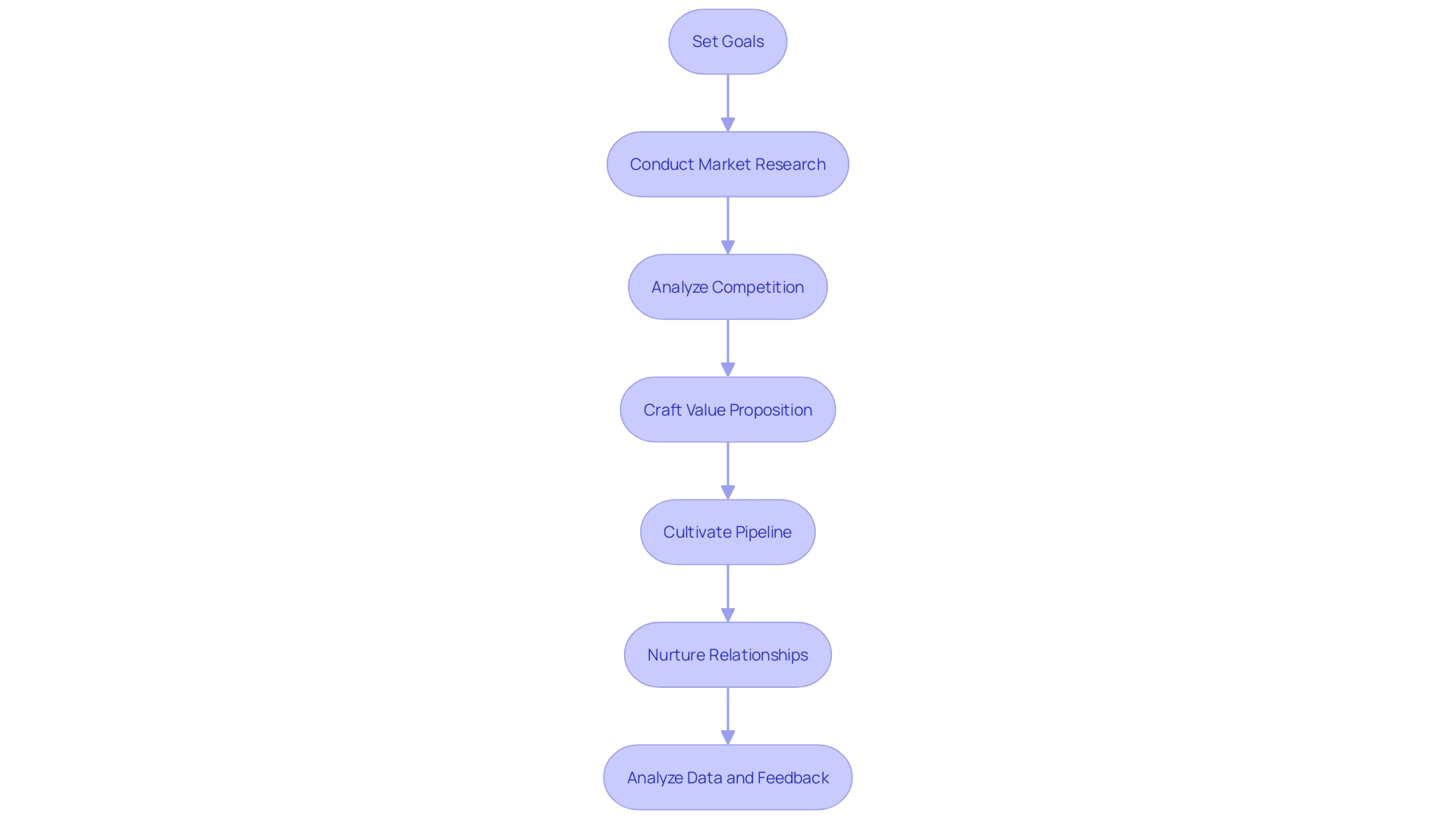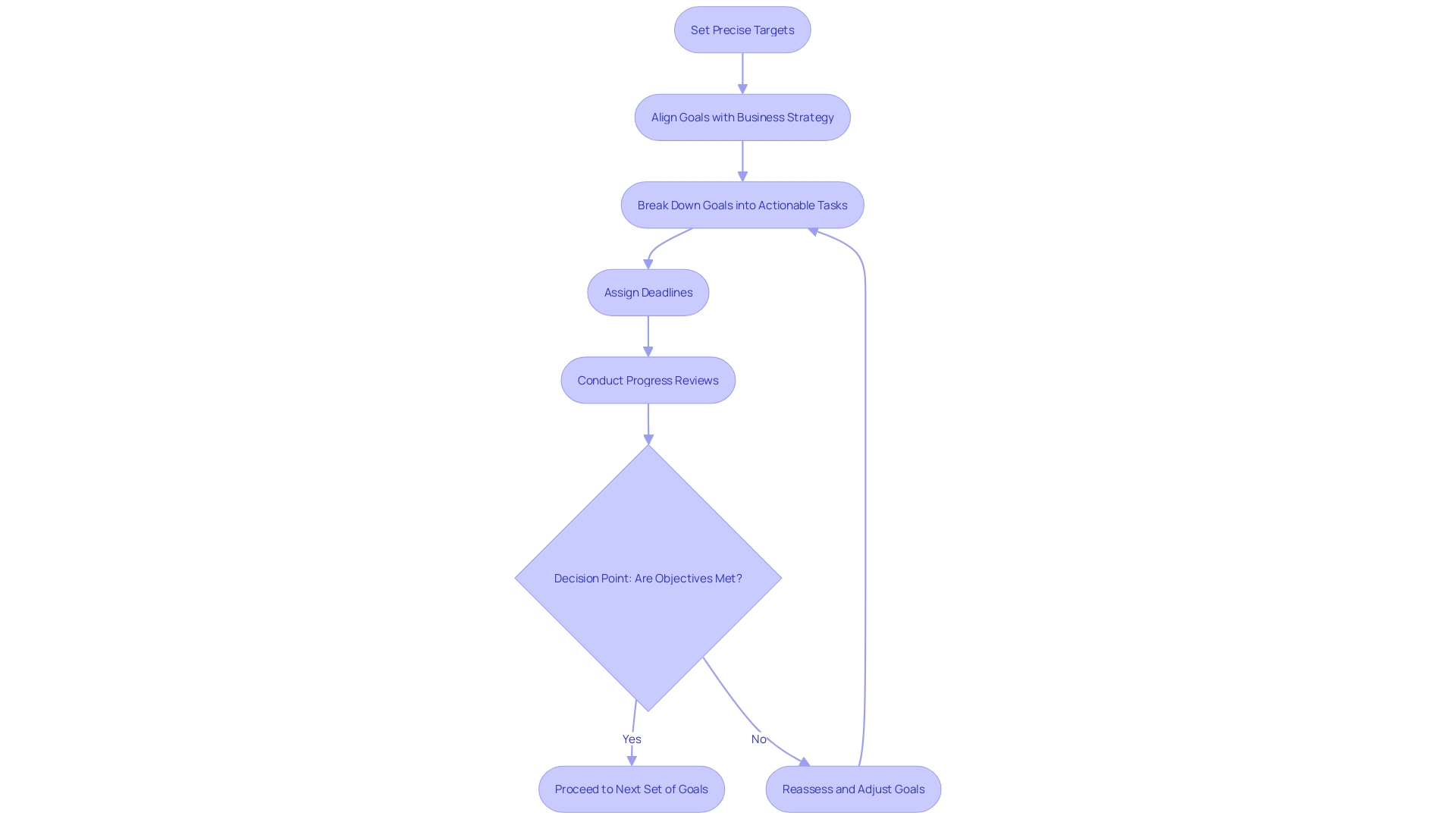Introduction
The core of business development lies in fostering growth through strategic relationships and opportunities. It's about intentionality in our actions to achieve desired outcomes and create value for both parties.
In this article, we will explore the importance of a business development mindset and the key roles within a business development team. We will also delve into creating a business development strategy, structuring the team for success, setting goals and objectives, effective communication and collaboration, measuring performance and progress, and best practices for business development teams. By understanding these elements, you will be equipped to cultivate a high-performing business development team and drive sustainable growth in your organization.
Understanding Business Development Teams
The core of business development lies in the mindset of fostering growth through strategic relationships and opportunities. It's about intentionality in our actions to achieve desired outcomes and promoting services in ways that create value for both parties. For professionals such as attorneys, financial planners, and accountants, who may lack a dedicated sales force, this mindset is crucial for generating new business.
As Vincent Burruano, a seasoned consultant, emphasizes, establishing a business development mindset is pivotal for forming mutually beneficial partnerships. At the heart of every successful organization are its people, who are the main drivers of growth and innovation. Managers play a key role in nurturing an environment that supports, respects, and trusts employees, enabling them to excel in their roles.
A strong business development team leverages the company's strategic assets which include intellectual property, data, and access to sales networks, as well as a strong brand, culture of innovation, and strategic partnerships. These assets are indispensable for a company to break through in the market. Understanding market dynamics is also essential.
A company must stay attuned to socio-cultural, economic, and technological shifts, using this knowledge to navigate growth paths effectively. For instance, prioritizing customer experience is paramount, as it shapes the perception of a company based on interactions with products, staff, and various channels. Poor-quality products can significantly tarnish customer experience, underscoring the need for a strategic approach to business development that is both internal and external, adapting to the evolving online sales landscape and user behavior as noted by Gilberto Marcano of open bots.
Key Roles in a Business Development Team
The dynamics of a successful business development team are as multifaceted as the markets they aspire to capture. At its core, a Business Development Manager orchestrates the team's collective efforts, strategizing for growth and steering towards objectives.
Their key responsibilities span across identifying fresh opportunities, negotiating contracts, and fostering client relationships, all while keeping a close watch on market trends and competitor movements. Sales Representatives are the vanguard of the team, their mission is to seek out leads, engage prospects, and secure business deals.
Their effectiveness is often bolstered by Market Research Analysts, who delve into data, discern market patterns, and distill insights to inform strategic choices. The art of forging and maintaining strategic alliances falls to Partnership Managers, while Relationship Managers dedicate their expertise to cultivating enduring client satisfaction and loyalty.
Elsewhere, the mastery of Negotiators comes into play during the critical moments of contract discussions and pricing agreements. This delineation of roles within a business development team mirrors the complexity of today's market where, as Gilberto Marcano of OpenBots points out, understanding the ever-changing online consumer behavior is paramount. The team's adaptability, informed by continuous learning and technology integration, can be the difference between stagnation and growth. It's a lesson echoed by successful ventures like Tech Ladies, which evolved from a small meetup to a multi-million-dollar community business, and RAIQC, an Oxford University Hospitals spin-off that revolutionized radiologist training with innovative technology. These case studies exemplify the transformative power of a well-rounded business development team in navigating the challenges of modern commerce.

Creating a Business Development Strategy
To forge a path toward sustainable growth, a business development strategy must be meticulously crafted. It begins with setting precise goals, such as revenue benchmarks, market penetration, or the introduction of new offerings. A deep dive into the target market is essential, unraveling the intricacies of customer needs, challenges, and behaviors.
This insight lays the groundwork for competitive analysis, pinpointing unique opportunities to stand out in the marketplace. The cornerstone of this strategy is a robust value proposition, tailored to resonate with customers by addressing their specific requirements and showcasing what sets your business apart. Cultivating a robust pipeline is the next logical step, leveraging diverse channels like industry networking, digital outreach, and word-of-mouth referrals to gather a rich pool of leads.
Equally vital is the art of relationship nurturing, ensuring consistent engagement with potential clients and partners by offering meaningful interactions. The strategy's potency is measured through diligent analysis, fine-tuning approaches based on tangible data and feedback. By embracing this structured approach, businesses can construct a dynamic business development strategy that not only aligns with their overarching objectives but also propels them towards pronounced growth.

Structuring the Team for Success
To ensure the success and growth of a business, the structure of the business development team is paramount. It's essential to have a trifecta of disciplines within the team: engineering, product, and UX.
Engineering focuses on the technical creation of the product, product team members pinpoint the features and user goals, while UX ensures the product is user-friendly and aesthetically pleasing. This powerful combination allows for a scalable, useful, and appealing product.
When hiring for your business development team, transparency is key. The process should be straightforward, detailing the precise responsibilities, salary range, and the company's remote work policy.
This clarity attracts top professionals and simplifies their pathway to joining your team. A business development manager's role is multifaceted, encompassing sales, marketing, and project management to drive long-term value from customers, markets, and relationships.
As such, delineating clear roles and fostering an environment where collaboration and idea-sharing are encouraged is crucial. Effective communication channels and ongoing training further enhance team synergy. Moreover, establishing clear performance metrics and goals is essential to track progress and pinpoint areas for improvement. Managers should support their teams with the necessary resources and guidance to thrive, as highlighted by the quote, "It's the people... Managers create this environment through support, respect, and trust." By incorporating these elements, your business development team is not only structured for success but also poised to contribute significantly to the company's strategic assets, such as intellectual property, data, sales networks, brand strength, financial health, innovative culture, and strategic partnerships.
Setting Goals and Objectives
To foster a high-performing business development team, it's crucial to establish objectives that resonate with both the aspirations of the team and the strategic direction of the company. Initiating with precise, quantifiable targets allows for effective monitoring and assessment.
For instance, Sean Ellis's concept of Product-Market Fit (PMF) provides a valuable metric: if 40% of users would be very disappointed without your product, you're on the right track. This level of user investment is a clear indicator of alignment with market needs and can be a pivotal goal for the team.
Aligning your goals with the overarching business strategy is another essential step. As Gilberto Marcano from OpenBots points out, understanding user behavior in the target market is a dynamic challenge due to the ever-changing nature of online sales.
Goals should thus reflect the need for adaptability in both internal and external business strategies. Furthermore, set challenging yet achievable objectives that consider your team's capabilities, ensuring that they are both desirable and feasible, as highlighted in the theories of motivation.
Assigning deadlines to these objectives instills urgency and fosters accountability. Breaking down ambitious goals into smaller, actionable tasks can simplify complex initiatives, turning them into attainable milestones. This approach aligns with the concept of categorizing business opportunities into 'Gold-mines'—opportunities that are both highly desirable and feasible. Lastly, consistent progress reviews and constructive feedback are imperative. They not only facilitate necessary adjustments but also keep the team aligned and motivated. Remember, stating there's no competition or failing to invest adequately in your venture can be a 'deal killer,' underscoring the importance of having 'skin in the game' and demonstrating commitment to your team's goals.

Effective Communication and Collaboration
Building a robust business development team necessitates a commitment to fostering a culture of open dialogue and cohesive collaboration. To harness the collective strengths of each team member, regular team meetings are essential.
These gatherings are opportunities to align on objectives, tackle challenges head-on, and identify new avenues for growth. In an environment where complex challenges are the norm, the synergy of diverse skills and perspectives is invaluable, enabling innovative solutions and greater adaptability.
Moreover, transparency in communication is a cornerstone of trust and efficiency. It ensures that all members have access to the information they need, promoting a shared understanding and a unified approach to goals.
The use of collaboration tools is another key element, streamlining communication, document management, and enabling real-time cooperation, which is critical in today's fast-paced business landscape. Cross-functional collaboration amplifies this effect, drawing on the specialized knowledge and resources from various departments such as marketing, sales, and product development.
This not only enriches the team's capabilities but also enhances the overall strategic execution. Active listening is equally important, as it validates the contributions of each team member, fostering an environment where all voices are valued. This is crucial for a team's adaptability and resilience, ensuring that a wide range of ideas and solutions are considered. Lastly, conflict is inevitable, but the manner in which it is handled can either strengthen or weaken the team's dynamic. Constructive conflict resolution is therefore essential, maintaining respect and unity within the team. By integrating these practices, a business development team not only increases its productivity and performance but also becomes a more agile and resilient force in the competitive business arena.
Measuring Performance and Progress
To optimize your business development strategy, it's essential to harness a variety of metrics that reflect the team's performance and its impact on business growth. Revenue growth remains a fundamental indicator, reflecting the team's effectiveness in closing deals and securing valuable contracts.
Lead generation metrics are equally critical, capturing both the quantity and quality of leads, alongside their conversion rates, to ensure a healthy sales pipeline. Additionally, the formation of strategic partnerships and alliances is a key metric that can have significant implications for business expansion.
To understand the customer perspective, customer satisfaction should be meticulously gauged through feedback mechanisms and retention analysis, providing insights into the customer experience and service quality. Moreover, the Pipeline Conversion metric is indispensable for assessing the business development team's proficiency in advancing prospects to the customer stage.
Individual team member performance must also be evaluated against set targets and responsibilities to ensure accountability and drive results. As underscored by McKinsey, while measuring productivity in areas like software development has historically been seen as challenging, it is indeed possible and necessary.
The effort-output-outcome-impact model, as discussed by industry experts, provides a framework that can be adapted to measure the effectiveness of business development activities. This model emphasizes not just the initial effort but also the tangible outputs, the outcomes of those outputs, and the overall impact on the business. Furthermore, understanding Customer Lifetime Value (CLV) is crucial, as it encapsulates the long-term value and engagement a customer brings to your company. This metric offers a comprehensive view of customer satisfaction and loyalty, which are pivotal for sustained business success. By regularly tracking these metrics, you can pinpoint both the strengths and opportunities within your business development team, guiding strategic improvements and fostering growth.
Best Practices for Business Development Teams
Elevating your business development team's efficacy hinges on several pivotal practices, each acting as a strategic asset to forge a path towards exceptional growth. Foremost is fostering Intellectual Property (IP) within the team, encouraging innovation and the safeguarding of patents, trade secrets, and unique methodologies. Data, both internal and external, must be leveraged effectively, underscoring a data-driven approach that informs decision-making and fine-tunes strategies.
Collaborative synergy between business development and marketing is essential, ensuring that sales and distribution networks are utilized to their fullest potential. This partnership aims to synchronize strategies and messaging, thereby enhancing lead generation and market penetration. Maintaining a robust financial position is another cornerstone, supporting a culture of continuous learning and professional development.
This financial stability underpins the team's ability to innovate and adapt to market shifts. Regular strategy reviews are crucial, aligning the team's direction with evolving market trends and overarching business objectives. Strategic partnerships also play a vital role, extending the team's reach through alliances with other companies, academic institutions, community organizations, and governmental bodies.
These relationships foster flexibility and adaptability, enabling the team to pivot in response to new opportunities and feedback. Lastly, a strong brand and the celebration of successes act as morale boosters, reinforcing team motivation and commitment. By integrating these elements, your business development team is positioned to thrive, driving sustained growth and achieving remarkable successes.
Conclusion
In conclusion, fostering a business development mindset is crucial for generating new business and forming mutually beneficial partnerships. A strong business development team leverages strategic assets, understands market dynamics, and prioritizes customer experience. Creating a well-crafted business development strategy involves setting precise goals, unraveling target market intricacies, and cultivating a robust value proposition.
Structuring the team for success requires transparency in hiring, clear roles and responsibilities, effective communication channels, ongoing training, and support from managers. To foster a high-performing business development team, it's important to establish objectives that align with both team aspirations and the company's strategic direction. Effective communication and collaboration are essential for harnessing the collective strengths of team members and promoting a culture of innovation.
Measuring performance and progress through various metrics such as revenue growth, lead generation, strategic partnerships, customer satisfaction, and individual performance evaluation provides insights for continuous improvement. Finally, implementing best practices such as fostering intellectual property within the team, leveraging data-driven decision-making, collaborating with marketing teams, maintaining financial stability, forming strategic partnerships, and celebrating successes contribute to the long-term success of a business development team. By understanding these key elements and implementing them effectively, organizations can cultivate high-performing business development teams that drive sustainable growth in today's competitive business landscape.





